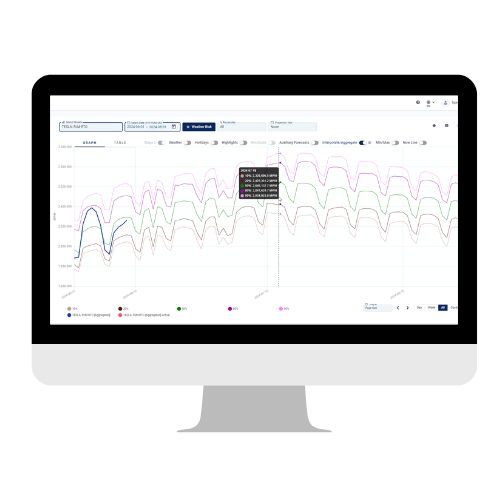Our Energy Demand Forecasting Model
%20(1).png?width=1905&height=950&name=image%20(41)%20(1).png)
Our Model
The Yes Energy Demand Forecasting model (formerly TESLA) consists of two parts: a highly parameterized nonlinear regression model and a time series filter for forecast adjustment based on recent experience. Combined, they offer significant accuracy advantages because a large number of people making a large number of independent decisions determine energy demand.
To attempt to model a system so complex, the model takes an information-intensive approach to the problem.
Our Basic Model Structure
At the simplest level, our energy demand forecasting model is specified as a stratified nonlinear regression model. We stratify the sample first between the summer and winter “seasons” delineated on the fall and spring clock change days and then again into three groups for each season: weekdays, Saturdays, and Sundays.
The model extensively uses two econometric techniques: variable parameters and piecewise linearization. It employs variable parameter models when the explanatory variables are normally significant in both the operational and statistical sense but the dependent variable's response to changes in them is not constant.
For example, in an energy model energy demand's response to changes in temperature is not the same across hours of the day or days of the week.
Piecewise linearization of the model recognizes that energy demand’s response to the relevant variables is not linear. Rather, the response is complexly nonlinear and can’t be modeled by imposing a simple nonlinear functional form.
Variables such as economic and population growth don’t vary quickly enough to be usefully included in a linear model of hourly or sub-hourly energy demand, but they do impact that demand.
Our energy demand forecasting model includes a single non-linear latent trend parameter designed to capture the collective effects of these slower-moving independent variables.

%20(1).png?width=1898&height=940&name=image%20(43)%20(1).png)
Our Error Correction Filter
Each model uses available observed and forecast weather inputs to solve the model described above for the week preceding the current day plus the forecast period. It then compares real-time observed demand data with the demand backcast over the preceding week to identify error patterns using a dynamically stable time series filter method. Once identified, the model uses those error patterns to make slight adjustments to the short-range demand forecast.




